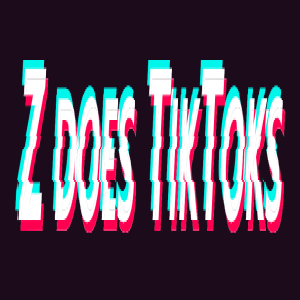Episodes

Thursday Apr 30, 2020
Thursday Apr 30, 2020
I worked with Marnette, and I always liked the fact that her wardrobe in middle management and then upper management was cut from a different cloth than the standard executive. Layered, frilly, colorful tops under antique-looking jackets (“I put on a jacket, it’s just not a jacket anyone else wears,” she says). They top multilayered skirts, concealing just the tops of well-worn, well-loved cowboy boots. She talks about bloomers, and because I’m oblivious, I never thought about the fact that she wore bloomers (handmade, by the way), but now that I think about it, yeah, bloomers. Who wears bloomers? Marnette wears bloomers. And they’re fun.
“I dress for fun,” she says. “I think it’s entertaining. I shop for the things I like for sport.”
It started with Halloween, she tells us, as she realized in her 30s that dress-up was amazing and she picked similar costumes every year: “I basically want to dress like a princess-witch-gypsy every day of my life,” she says. Other people describe it as “boho chic.”
I could’ve asked Marnette for pictures of her favorite outfits, but, y’know what? Marnette dresses for herself. If you want to talk to her about this, you’ll just have to email her.
I’ve only scratched the surface. There are leadership and confidence thoughts here along with wisdom that comes with successful experimentation like this in life. Don’t miss Marnette’s centered approach to people’s judgment about style, how personal expression fits into the corporate world, and how it makes her more confident.
WANT TO KNOW MORE?
> Marnette says she has a hard-and-fast rule: She only wears what she loves. She was Marie Kendo before Marie Kendo was a thing. (Kendo’s rule 6 is “Ask yourself if it sparks joy.” If not, say, “thank you” for its service and get rid of it.) Wait, you already heard about Kendo and you’re sick of her? Now you’re a part of the wonderful cycle of 1) See a new thing, 2) Love a new thing, 3) Get tired of a new thing, 4) Hate the new thing? Read this and this and this and enjoy your irritation.
> Marnette loves Pinterest. and see if her style is your style.
> Where does she get her ideas and her clothes? She mentions Pinterest (see her boards), thredUP, thrift stores, boutique stories (a little price-y) and her own two hands (she makes her own bloomers).
> I ham-handedly describe one impression I have of Zen Buddhist poetry and practice. I don’t know enough about this. Who let me talk? Get a different view of Zen’s play with language. Taste some Zen Buddhist poetry. Shake things up with a Zen Buddhist koan, a seemingly nonsensical whack to the proverbial head to awaken you?
(IMAGE CREDIT: The Spanish Gypsy "Preciosa" by Bisson Freres)

Monday Apr 20, 2020
Monday Apr 20, 2020
Yeah, who’s the guy who cut off his guest at the start of the podcast recording? That would be me. His name is Peter, and he’s an environmental engineer for a steel company.
He started as a mechanic out of high school, headed for physics in college to become a professor, but then found a love for geology and graduated with a degree in that.
He does a lot of paperwork, but he also does a lot of site visits and gets to get his hands dirty sometimes.
“I still enjoy getting outside, and I don’t know if I’d want to be cooped up inside all day,” Peter says about a potential life in academia.
Learn about steel recycling, electric arc furnaces vs. blast furnaces, and more. My favorite part? Peter fights back against my question about having an unsolvable problem. There really is no such thing, you’ll find out: Tackle it in baby steps until you get closer, he says.
WANT TO KNOW MORE?
> No, no, NO. An environmental manager (Wikipedia), not an environmentalist (Merriam-Webster.com).
> Curious about electric arc furnaces? Watch this video. (No, this isn’t Peter’s company, and no guarantee this is what this looks like in his facilities.)
> Peter used to work on Saturns. Remember those?

Thursday Apr 09, 2020
Thursday Apr 09, 2020
Jennifer likes to draw dragons. Fantasy monsters and people, elves, things out of fantasy books. Animals. (Her sketch of Batgirl was my smartphone wallpaper for weeks.)
"I get ideas in my head of something that would look cool of a scene or an animal, and I like sharing that idea," Jennifer says.
Like many artists who don't do it for a living, she usually doesn't need to hit deadlines that aren't self-imposed and doesn't need to draw stuff she doesn't care about. Much of her art is for her, her own heart, her own interest and the interest of friends and supporters (like the folks at her workplace who were encouraging and kicked off her adult art kick). Before, when she drew as a kid, she says she "didn't have the support system. It was getting in my own head a lot. Being very negative toward my own stuff."
"Becoming more involved with the internet ... has helped that too," she says, "because I'll throw my art out into the world and people will ... click 'Like' on it. And it won't be a lot of people, but it'll be a few people, and I'll [say,] 'Oh, I don't know that person, and they liked my art, so I ... made a random stranger happy by posting this.' That brings me joy."
Jennifer discusses the power of pre-work before art projects (when she doesn't, sometimes she notices "this one thing is off, and I could have changed that, but in order to change it ... I have to start over"), what making art feels like and how coworkers' and friends' support brought her back to art as an adult.
Note: After about 39 minutes, this podcast peters out a bit into Jennifer and I bandying back and forth, as we search for stuff on the internet to recommend (all below in "Want to know more?") and I mangle the spelling of her online handle.
WANT TO KNOW MORE?
Find Jennifer on Instagram (drawntofury), Patreon (caeodos) and Twitter (caeodos1)
Want to try an art challenge or exercises? Especially 'cause most of us are stuck at home during the pandemic? Jennifer mentions ...
Intokber (art prompts and shared results)
The Etherington Brothers (unique art style and drawing ideas)
the Jake Parker weekly e-newsletter (with prompts and more)
The Sketchbook Project (with DIY sketchbooks and the chance to send them back to a library to be digitized and shared)
Sketchbook Revival (a free regular event with Karen Abend and others)
Toothless from the "How to Train a Dragon" movies based on a cat? Yeah. Want to see a Tortle? Yeah you do.
Curious about Dungeons & Dragons? It was the gateway drug (check out this flowchart at Wired) for so many middle-aged nerds today, and it maintains its strength as the dominant tabletop role-playing game in the market with its new owner Wizards of the Coast (which also owns the Magic: The Gathering card game, which I play online). Jennifer also mentions Critical Role, a very popular online show featuring voice actors playing tabletop D&D.

Friday Apr 03, 2020
Friday Apr 03, 2020
Note: There are a few four-letter words sprinkled throughout these 45 minutes. Instead of “feces,” we, umm, say, y’know. That S-word. Skip this podcast if that bothers you.
As we all sit through this COVID-19 crisis, packed under "stay at home” orders in most states, it’s a good time to remember, yes, the toilet paper you’re having trouble finding, but also that wonderful sewage system that keeps your shelter nice and safe.
As far as I’m concerned, keeping the system working is one of the most important jobs around. A quote attributed to Gandhi agrees: “Sanitation is more important than independence.” Armies can dig trenches for poop and move on. Thinly populated farms can use outhouses. But without a place for urine and feces to go, we can’t be packed like sardines into modern urban and suburban environments.
Electro mechanic assistant Kevin works on sewer lift stations. He helps make sure they keep running. As you’ll learn in the podcast, most water and sewage moving around a city uses gravity as much as possible (most everything with liquid is pitched at very small angles to keep it moving, he says), but when stuff collects lower than where it needs to go, Kevin’s motors push it on through to its next destination.
“It’s like a rollercoaster,” he says. “My sewer lift station is the thing that lifts you up to the top of the hill so you can ‘gravity’ back down to wherever you’re going.”
Kevin also explains a bit how he got into this gig (no, he didn’t pick poop on purpose), what he wants you never to flush in the toilet, what smells the worst down there ("Poop’s not even close,” he says. “And it’s oily. It sticks.”) and what’s the creepiest living thing he’s seen running around.
“This job is stable,” he says. “I don’t think anyone’s gonna’ stop pooping in the near future.”
Warning, all the best stories are in the last 20 minutes or so. Don’t skip!
Want to know more?
The Environmental Protection Agency has an eight-pager on sewer lift stations. Nerd out.
Early on, Kevin talks about folks who keep the pipes clean, using rodders and jetters (links go to Youtube videos about those devices, but not the exact devices Kevin’s colleagues use).
In addition to Kevin’s No. 1 choice for stuff not to flush, don’t dump F.O.G. Here’s one utility’s FAQ.
Kevin schools me on motors and engines; he’s mostly right. Brush up on your terminology with a layperson-friendly explanation from MIT.
Kiewit’s fleet of Caterpillar equipment is mentioned. Kiewit builds stuff. Like everything.
The insect Kevin says he hates the most is a house cricket. We don’t think that’s it. We think he means a big one of these.
Hyperion is big, and Kevin’s never been there. But this website story calls it the “Disneyland of Poop.”
CAPTION: "Abercynon" by gwallter is licensed under CC BY-NC-SA 2.0

Thursday Mar 26, 2020
Thursday Mar 26, 2020
Note: I happened to record this podcast as the world's coronavirus pandemic started to kick into gear. I'm now back home under the similar "shelter in place" order (or some version of it) that you are. This one seemed usefully short and easy for my first week under quarantine. Stay safe. :)
Zahara just turned 11, and this podcast is short. She's not necessarily used to answering detailed questions, hearing herself blather on (like me) and she had no preparation. She did a great job.
Zahara says folks use TikTok for dances, for art, for anything short and visual. I got onto TikTok a few months after it started, got bored with it and came back to it to keep up the young un's. It is hellishly addictive, providing just enough amusement to keep you swiping up and down. Some creators are phenomenally talented at whatever craft they're showcasing, but I agree with a creator's video I saw a while ago: TikTok is designed to give mediocre people the chance to do fairly mediocre things and maybe blow up virally from it. ("They're dances that people make up to songs, and then other people do them," she says.) In other words, amazing dancers doing dances are viral ... but so are any good-looking for high-energy Tomasina, Dick or Harriet.
There are also sad videos, where a TikTok user makes one to sing about or dance about or talk about, "like, when your dog has to go to the hospital," she says.
Zahara's account is private, only for friends, per her father. :)
Want to know more?
TikTok is this. Tik-Tok is this. There's a big difference. Tik-Tok's dancing skills are way under par for the preteen girls on TikTok.
TikTok has a darker side, so watch over those kids, gang.

Thursday Mar 19, 2020
Thursday Mar 19, 2020
I am a convert to Judaism, and Joshua is a convert to the Catholic Church. And he has always been one of the most fun people to talk about religion with, which led me to understand that us weird converts have something about us and our journeys that crosses spiritual paths. There is something about being a person who chose a faith that is always a little different than someone born into one. (If you hear us thumping the table a lot, forgive us: We're excited converts.)
Joshua exemplifies the intensity of the convert, having traveled from dissatisfaction with religion in his teenage years to marrying his awesome wife, and the both of them growing into a life of service and learning in their new church.
Today, he's a permanent deacon for the Roman Catholic Church, a level of lay leadership and service to the Church. Joshua explains what drew him to the diaconate and what it's like doing the work. (He had to go through the stages of Instituted Lector and Instituted Acolyte, FYI, which were set up with Vatican II back in the 1970s.)
The process is a lengthy curriculum of study, service and spiritual growth over five years. And anywhere along the way, the people watching your development in the program can tell you, y'know, this isn't for you.
"It's the Church, your wife and yourself making the decision, is this calling really there?" Joshua says.
And Joshua was never totally sure; he says he understood deeply his own flaws, and he always wondered whether he belonged in this service: "I know all my own sins and my past, and I'm going, 'I'm not the pious guy who should be a deacon.' But ... God doesn't use pious guys all the time. Sometimes he goes out and finds the guys with that past, and you can talk to those people living in those circumstances ... and explain to them the faith."
He also shares a very personal tale of dreams that guided him toward God and through life as well.
Joshua's spiritual and religious journey is a fascinating one, and you'll learn some awesome stuff about what's happening during that Catholic service.
Want to know more?
The Archdiocese of Newawk (New Jersey) has a bit more about the history of the position (it's new ... and old!) in the Roman Catholic Church.
Here's one diocese's deacon formation application 22-pager.
Joshua mentions the four pillars of deacon formation. Bam!
Want to get a little more feel for the reverence, ritual and tradition Joshua likes as a self-described "traddy" (more Latin, older hymns)? Check out this interview with a fellow traditionalist Catholic (Joshua didn't suggest this, so this may or may not represent Joshua's feelings)
Yup. Bible stories on felt board is definitely a thing.
Want a feel for what's on that altar with Joshua and the priests? Check this sample out.

Tuesday Mar 10, 2020
Tuesday Mar 10, 2020
I worked with Theresa Entriken, DVM, for many years at a company that offered magazines, websites, podcasts, educational products and national conferences to veterinarians and their team members. But I wanted to come at this veterinarian from a tangent: birdwatching.
While an avid hiker, Theresa says she glommed onto the hobby from her husband (also a veterinarian).
“Hiking, I do like to do for exercise, you cover a lot of ground,” she says. “When I hike with my husband, it’s a lot slower, because you tend to stop and look at things you see fluttering in the trees. And I do like to bird by ear, observing what’s in your environment and just putting the images to the sounds.”
Imagine, then, hiking … only with an intense curiosity constantly pricking up your ears your eyes scanning the trees and the skies, your ears listening and your footsteps falling more gently to catch a distant bird call. Theresa’s thoughtful, measured voice puts me perfectly in mind to imagine a crisply cold, quiet birdwatching trip in a Minnesota bog.
“It’s slowing down and taking notice of what’s around you,” she says. “[Birds] are these biological works of art that are just available for you to enjoy.”
Found out what a “life bird” is, whether birdwatching is ever not relaxing but frustrating, and why Theresa is fired up about suburban backyard plants for conservation.
Want to know more?
Yes, scientists think birds are descended from dinosaurs. Cool, right?
What locations does Theresa mention? Sax-Zim Bog in Minnesota (check out their friends page on Facebook or their website), Lyon State Fishing Lake in Kansas (website) and Loess Bluffs (website) and Marais des Cygnes, the latter two both in Missouri (website).
What are some specific animal species she mentions? American Three-Toed Woodpecker (photos), Barred Owl (photos), Boreal Owl (photos), Gray Fox (photos), Great Gray Owl (photos), Great Horned Owl (photos), Long-eared Owl (photos), Northern Hawk Owl (photos) and Spectacled Owl (photos).
Theresa talks about a birding database, a cool citizen science and hobby app, at eBird.org.
What does a birdwatcher’s list – their version of a personal avian bingo card – look like? If you want it prepackaged for you, maybe something like this.
The coolest toy, of course, as Theresa says, is binoculars. Pick up a cheap pair at retail to get started. If you really get into it, then you can invest hundreds of thousands of dollars in a stellar pair of binoculars or even a scope on a tripod.
Theresa’s enthusiasm about birding got me to start reading a book that’s been on my bookshelves for more than a year.
Last but not least, Theresa says folks interested in wildlife and birdwatching should check out their state’s conservation magazines. Here’s a sampling I found searching on the internet right now:
Outdoor Alabama (website)
Alaska Fish & Wildlife News (website)
Arizona Wildlife Views (website)
Arkansas Wildlife (website)
Colorado Outdoors (website)
Connecticut Wildlife (website)
Outdoor Delaware (website)
Outdoor Indiana (website)
Iowa Outdoors (website)
Kansas Wildlife & Parks Magazine (website)
Kentucky Afield (website)
Louisiana Conservationist (website)
The Maryland Natural Resource (website)
Massachusetts Wildlife (website)
Minnesota Conservation Volunteer (website)
Mississippi Outdoors (website)
Conservation Magazine in Missouri (website)
Montana Outdoors (website)
Nebraskaland (website)
New Hampshire Wildlife Journal (website)
New Mexico Wildlife (website)
New York State Conservationist (website)
Wildlife in North Carolina (website)
North Dakota Outdoors (website)
Wild Ohio Magazine (website)
Outdoor Oklahoma (website)
Pennsylvania Wildlife (website)
Wild Rhode Island Journal (website)
South Carolina Wildlife (website)
South Dakota Game, Fish and Parks Conservation Digest (website)
The Tennessee Conservationist (website)
Texas Parks & Wildlife (website)
Virginia Wildlife (website)
Wisconsin Natural Resources (website)
Wyoming Wildlife (website)
Miscellaneous
Anthropocene (website)
Audubon (website)
Defenders of Wildlife (website)
Mother Earth News (website)
Nature Conservancy Magazine (website)
National Parks Magazine (website)
National Wildlife (website)
Sierra (website)
Spire: The Maine Journal of Conservation and Sustainability (website)

Thursday Mar 05, 2020
Thursday Mar 05, 2020
For my debut episode, I introduce to you both good and bad. Let’s start with the bad. I ask board-certified music therapist Rachel Rilinger questions from a distant location, which is really right across the table from her, but apparently I, as a grown adult, can’t manage my settings on my microphone. But you didn’t want to hear from me. The good part of this episode is all the great stuff from Rachel!
We kick things off with Rachel by talking about certification for music therapy. Don’t stop here. Keep going. She respects the education and the work of her chosen profession, which she reveals she’s been excited to do since she was 15 years old. Then we get into what’s really amazing about music therapy, how it helps with mental illness, rehabilitation, chronic conditions – with everything where music can be a modality to heal and help.
You’ll hear Rachel’s origin story and feel her intense passion for the work. You’ll even get a little about the neurology behind music and why it can do things other therapy and treatment can’t. And you’ll get to hear Rachel rock the autoharp. (After demonstrating the power of ascending and descending notes, she says that “in a nutshell, our brain wants to do what the music’s doing. We’re built to respond to that.” And that can be put to therapeutic use.) And, finally, Rachel touches on the mystery of life, the “why” and the spirituality behind music. Last but not least, don’t leave before Rachel tells her story about the power of music therapy. (“There are times when I felt like a magician,” she says.)
As for the audio quality, maybe by the third of fourth episode I’ll have my crap together? Stick with me. Can you believe what amazing things people do?
Want to know more?
Need more details on music therapy? Maybe think you want to be one or know someone who’d make a great one? Want to see the definition of music therapy Rachel likes? Want to hear about legislation in your states that supports the professionalizing of board-certified music therapists? Want to find a music therapist? Find out about this profession from the American Music Therapy Association.
Rachel plays an autoharp in this episode and explains why it’s amazing. Here’s more on this cool instrument.
And, yes, the Tibetan Book of Living and Dying has Rachel’s frog story. (It’s on page 42 here.)

Tuesday Feb 11, 2020
Tuesday Feb 11, 2020
I had an amazing interview with Jahmal Brown, somebody who gets people and games and nerd culture and is an all-around exciting person to bounce ideas off of. I even got to meet his awesome dog. And my own user error scuttled it all. So. Yeah. His website is madjayzero.com. Check it out.

What People Do: Interviews of Discovery
When COVID happened, I started talking to friends, family and acquaintances about something they did. The topics, personalities, and conversational directions go many different ways, but the important thing remains the same: We are all worth the time it takes to sit down and talk a while to each other. What would you learn if you slowed down, asked more questions, and delved into something interesting to ... someone else?



